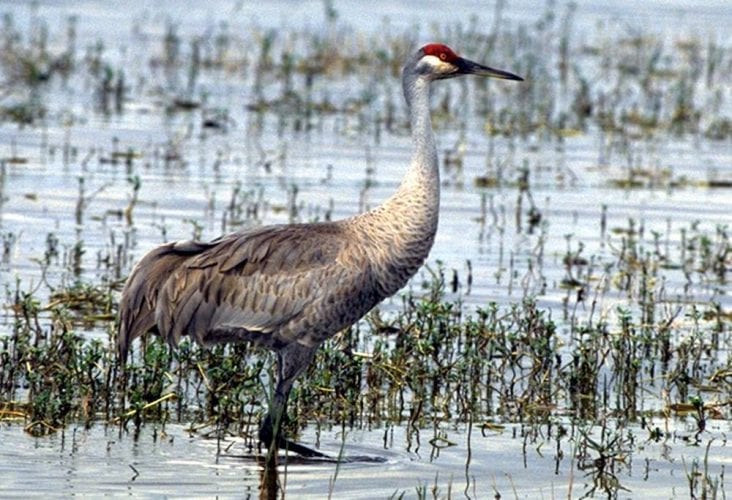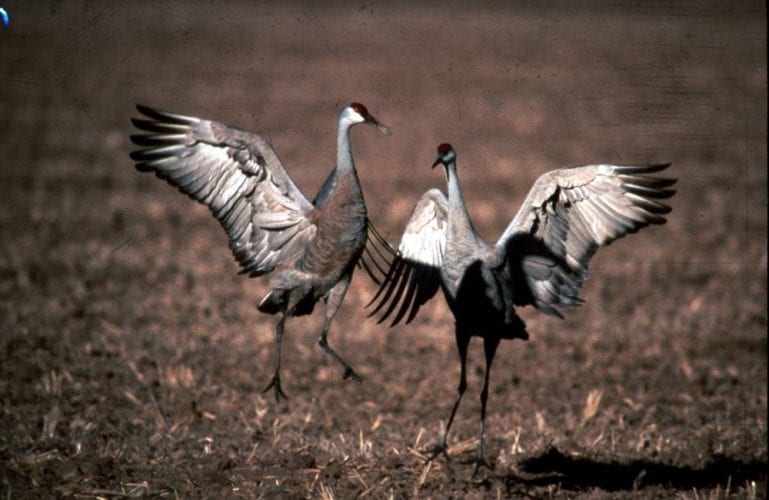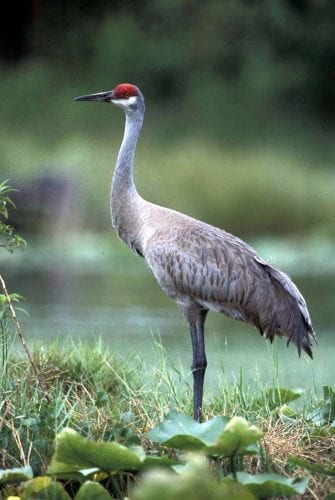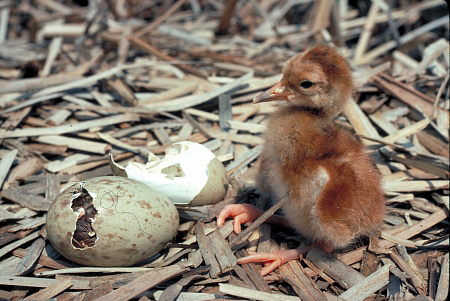
International Crane Foundation, “Sandhill Wading,” Crane Media Collective, accessed April 19, 2019, http://gallery.savingcranes.org:8082/items/show/16854.
Item Relations
Sandhill cranes could be the oldest bird species in the world. They’re some of the first birds to move through Southeast Alaska during spring migration. But where are they going and what do they do when they get there? Angela Denning talks with a sandhill crane scientist to find out more:
Nothing sounds quite like spring like the sound of sandhill cranes. You often hear them before you see them. Their calls can carry for over two miles.
“They’re doing contact calls when they’re migrating,” said Dr. Gary Ivey, a Research Associate with the International Crane Foundation. “They’re saying, ‘I’m here, I’m with the flock, are you back there?’ They’re talking to each other.”
Ivey is based in Bend, Oregon and studies sandhill cranes throughout the Pacific Flyway. He says they have different kinds of calls for different reasons: for danger, for bonding, for territory, for their young.
“I personally think that cranes can communicate as well as we can,” Ivey said. “But it’s not just their calls, it’s also their body language and different postures they take.”
There are three subspecies of sandhills—the greater, lesser, and Canadian. They are all large, gray-bodied birds with a long necks, big beaks, and bright red crowns. They stay mostly on the ground, not roosting in trees like herons or egrets. Despite their size, sandhill cranes move with relative ease, and are known for their dancing.
“They will dance all year,” Ivey said.

International Crane Foundation, “Sandhill Cranes Dancing,” Crane Media Collective, accessed April 19, 2019, http://gallery.savingcranes.org:8082/items/show/16861.
Ivey says the cranes dance for several reasons. Sometimes it’s to relieve stress, say if humans are around.
“It’s called displacement behavior, it relieves stress. They’ll start dancing, sometimes the whole flock will dance,” Ivey said. “They do practice dancing all year and it’s also a way to attract a mate. So, these females and males may be courting in the middle of the winter or during migration so you can see that all year. But when they get to their nesting territory and before they start laying eggs they do a lot of dancing.”
The cranes flying over Southeast usually breed and nest around the low lands of Bristol Bay and Cook Inlet. They leave the state in mid-September to early October and fly south to winter in California. The Stikine River Delta is a pit stop for some of them. The area can also see Canadian sandhill cranes nesting in the summer time.

International Crane Foundation, “Sandhill Crane,” Crane Media Collective, accessed April 19, 2019, http://gallery.savingcranes.org:8082/items/show/16860.
“So, it’s like people that have a house in Alaska say and they have a house in Arizona. These cranes have property in Alaska and they have property in California that they go to and they have their favorite restaurants on the way down,” Ivey said.
The vast majority of cranes using the Pacific Flyway are lesser sandhill cranes. There are about 35,000 of them compared to 5,000 Canadians.
Sandhill cranes are one of the oldest known bird species dating back 2.5 million years ago, according to fossils. 10 million year old fossils in Nebraska are of cranes related to sandhills. The species has evolved to be opportunistic eaters, consuming plants and small animals alike. Voles are a favorite.
“Cranes are the closest thing to the dinosaur in the bird world that I’ve seen,” Ivey said.
Some sandhill cranes mate for life. They use a “unison call” to set them apart from other pairs.
Usually pairs lay two eggs. They take about a month to hatch and two and half to three months for the chicks to fly.

International Crane Foundation, “Sandhill Crane Chick,” Crane Media Collective, accessed April 19, 2019, http://gallery.savingcranes.org:8082/items/show/16859.
Many chicks are killed by predators but if they make it into adulthood the birds can live for a really long time. Scientists don’t know exactly how long because tags on the birds for tracking projects often don’t last for decades.
“I think they have the potential to live as long as us, we just can’t identify those really old birds,” Ivey said. “I suspect there’s some 50 year old birds out in the wild if not older.”
One tagged bird was tracked until it was 40. In captivity, the species has lived to nearly 70 years.
A flock can have all ages of cranes in it but even just one crane can leave a memorable song in the air.
Crane expert, Dr. Gary Ivey, will be in Wrangell as the keynote speaker for the Stikine River Birding Festival, April 25-28. The festival celebrates the spring migration of millions of birds from bald eagles to shorebirds.










